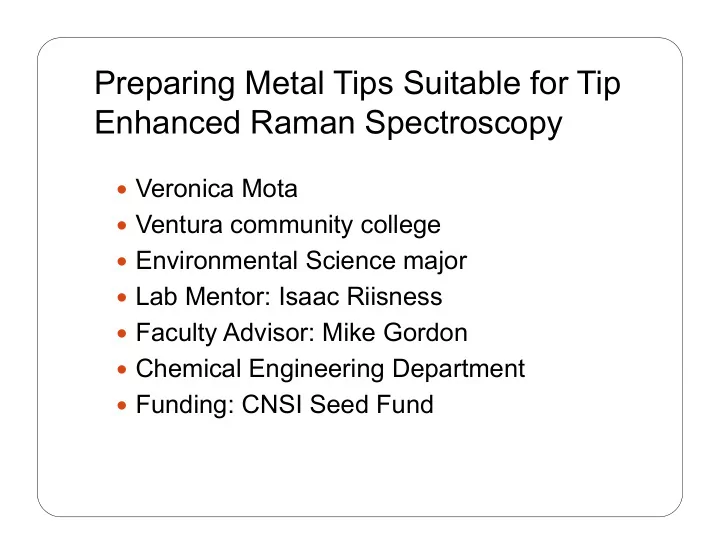

Preparing Metal Tips Suitable for Tip Enhanced Raman Spectroscopy Veronica Mota Ventura community college Environmental Science major Lab Mentor: Isaac Riisness Faculty Advisor: Mike Gordon Chemical Engineering Department Funding: CNSI Seed Fund
The Big Picture The Big Picture Surface chemical imaging via Raman Spectroscopy Spectroscopy. TERS; Physical properties and chemical properties of molecules as well. Applications; images of Applications; images of biomolecules and study of catalytic surfaces. Picture of E.coli bacteria taken with SEM with SEM.
Tip Enhanced Raman Spectroscopy(TERS) Ti E h d R S t (TERS) Laser is directed at surface and metal tip. f d t l ti Z Enhanced Enhanced Molecule; two types of X Raman Y Field scattering occurs. g Scattering Raman Tip Tip; laser light excites Scattering electrons.(plasmonic Rayleigh coupling) coupling) Scatt Scatt. Laser Enhanced Electromagnetic field is Surface created. created Tip enhanced Raman spectroscopy Only Gold and Silver enhances Raman scattering. can be used.
Goals Goals Tip Tip vs. Tip Enhancement Allows Sub- λ details to propagate Metal tip is the main reason for field enhancement. M t l ti i th i f fi ld h t Quality of tips is of importance, the sharper the tip the better the enhancement. Preparation and Characterization of metal tips to be used in Tip-enhanced Raman Spectroscopy.
Electrochemical Etching Setup for Gold Tips + - Electrolyte composed of 1:1 HCl and Ethanol by volume Electrolyte composed of 1:1 HCl and Ethanol by volume. The gold ring and wire are suspended from hooks which are in turn connected to a voltage regulator. The anode is connected to the (+). The cathode is connected to the (-).
The Etching Process The Etching Process Chloride ions react Chloride ions react with the gold wire producing AuCl 2 in solution. The Cl ions keep t trying to react with the i t t ith th gold in the wire. Reactions Occurring: Voltage regulator Voltage regulator 3 4 , 1 . 002 AuCl e Au Cl E V stops the etching 4 0 AuCl e Au 2 Cl , E 1 . 154 V process. 2 0 A Cl AuCl 2 2 e A Cl AuCl 2 2 Cl Cl , E E 0 0 . 926 926 V V 4 2 0
10 µm 10 µm 10 µm At 2.4 volts At 2.0 volts Gold tip etching • Preferred voltage is 2.4-2.5v for .250 mm wire in HCl/Ethanol solution. • After experimenting with new wire(0.04mm) realized smaller wire requires After experimenting with new wire(0.04mm) realized smaller wire requires smaller voltage.
10 microns Reused solution Fresh solution Tungsten Etching • Preferred voltage 7.5v in 3M KOH solution • Concluded tip quality becomes worse after subsequent reuse Concl ded tip q alit becomes orse after s bseq ent re se of solution.
Before After 10 microns 10 microns Tungsten silver plating • Plating solution composed of AgNO 3, KI and H 2 SO 4 • Voltage of 3.0 v • Reaction time 20-30 seconds
10 µm 10 µm New solution etching First trial silver etching Silver Etching • First trial electrolyte: ethanol, ammonia, and Hydrogen peroxide, 20-24 v • Resulted in dull tips • Resulted in dull tips • New Solution: Ammonia /Ethanol 5:1 by volume • Voltage; 10.5v
Summary Summary Several different tips were made in different solutions and voltages. Gold ; smaller wire requires smaller voltage. Tungsten ; reuse of solution produces less fine f l ti d l fi T t tips over time. Silver ; produced successful tips with ammonia Silver ; produced successful tips with ammonia ethanol electrolyte.
Achievements Achievements Advantages of tip enhancement in Raman Tuning fork AFM; our approach Tuning fork AFM; our approach Spectroscopy. Traditional AFM How electrochemical etching works. How an electrolyte and it’s concentrations affect H l t l t d it’ t ti ff t the end product when making tips. Voltage and it’s effect on a reaction and it’s end Voltage and it s effect on a reaction and it s end Surface Surface product(tip). Achieved a successful silver etching procedure. c e ed a success u s e e c g p ocedu e Used tungsten tips in AFM (atomic force AFM scan with tungsten tip microscopy) calibration.
Future Plans Future Plans Improving silver etching Using gold and/or silver for actual TERS Seeing if silver plating of Tungsten will in fact produce successful scans. d f l
Acknowledgments Acknowledgments UCSB INSET staff INSET group members for helpful feedback P.I Mike Gordon Mentor Isaac Riisness Entire Gordon Lab
Recommend
More recommend